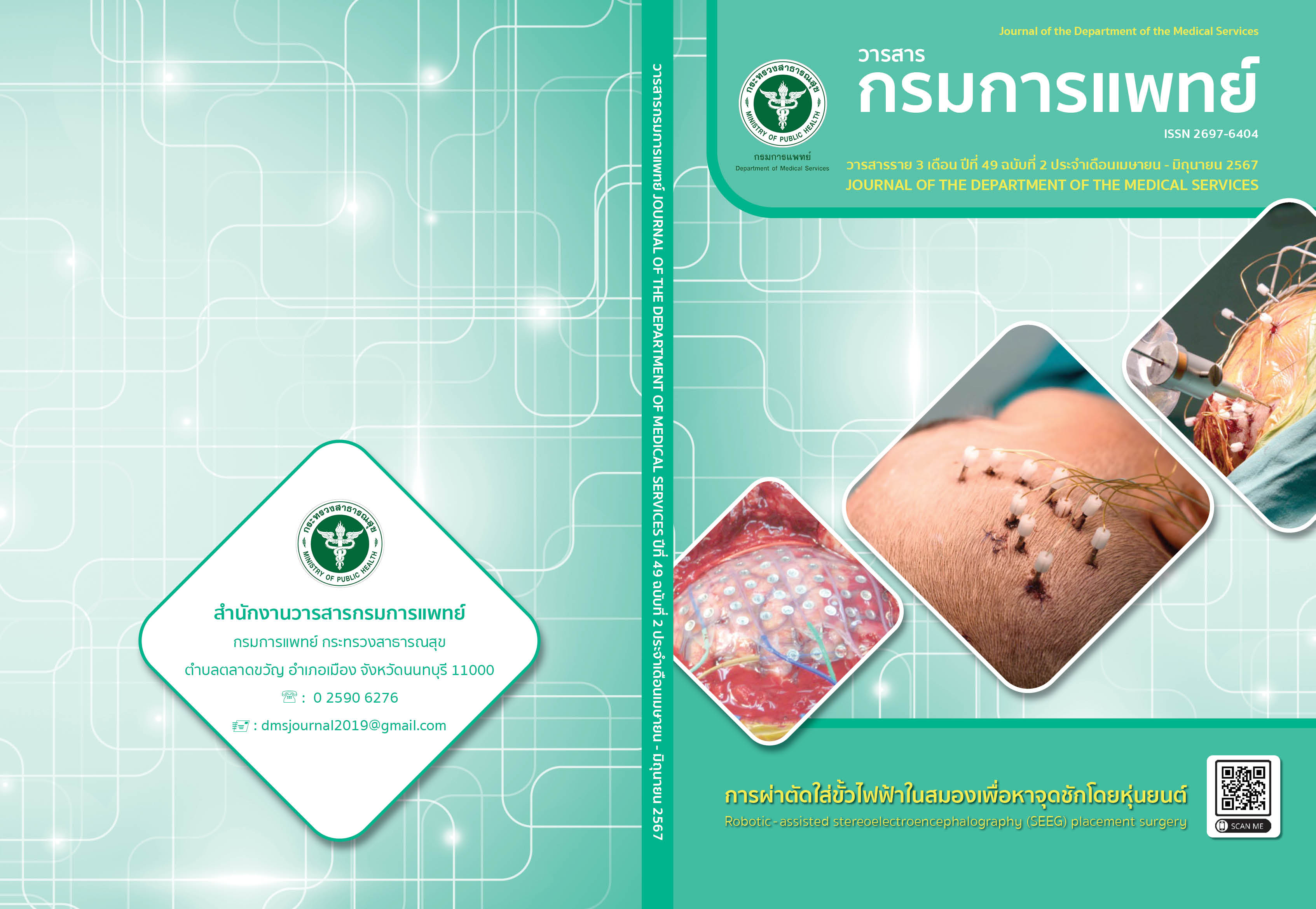Prevalence of Sacral Dysmorphia of Patients in Rajavithi Hospital, A Retrospective Study
Keywords:
Sacral dysmorphia, Thailand population, Percutaneous screw fixationAbstract
Background: Sacral dysmorphia entails abnormal anatomy of the upper sacrum. Dysmorphic sacra have narrow and angled upper osseous corridors, increasing the risk of cortical perforation during iliosacral screw and transacral screw insertion. To date, no statistical data regarding this condition exist in Thailand. We aimed to collect statistical data for this patient group in Thailand. Objective: To determine the prevalence of sacral dysmorphia among patients at Rajavithi Hospital. Methods: Data were collected from Rajavithi Hospital’s database for the past 5 years, from January 1, 2016, to December 31, 2020, and analyzed to determine the prevalence of sacral dysmorphia and safe corridors for percutaneous screw fixation at the sacrum. Results: A total of 594 patient records were collected. Sacral dysmorphia was found in 136 cases, accounting for 23%. Gender was found to have no effect on disease prevalence but did affect sacral size, with males being significantly larger. The sacral dysmorphia group had 94.1% unable to insert a transacral screw at position S1, with an average width and height of 15.46 and 17.00 mm, respectively. At position S2, both iliosacral and transacral screws of all sizes (6.5, 7.0, and 7.3 mm) could be inserted, with average width and height of 13.98 and 17.84 mm, respectively. Conclusion: We recommend using the S2 position instead of the S1 position for percutaneous screw fixation in individuals with sacral dysmorphia due to advantages including safety, low complication rates, ease of surgery, and strength.
References
Miller AN, Routt ML Jr. Variations in sacral morphology and implications for iliosacral screw fixation. J Am Acad Orthop Surg 2012;20(1):8 - 16.
Hasenboehler EA, Stahel PF, Williams A, Smith WR, Newman JT, Symonds DL, et al. Prevalence of sacral dysmorphia in a prospective trauma population: Implications for a “safe” surgical corridor for sacro - iliac screw placement. Patient Saf Surg 2011;5(1):8.
Routt ML Jr, Simonian PT, Agnew SG, Mann FA. Radiographic recognition of the sacral alar slope for optimal placement of iliosacral screws: a cadaveric and clinical study. J Orthop Trauma 1996;10(3):171 - 7.
Kaiser SP, Gardner MJ, Liu J, Routt ML Jr, Morshed S. Anatomic determinants of sacral dysmorphism and implications for safe iliosacral screw placement. J Bone Joint Surg Am 2014;96(14):e120.
Gardner MJ, Morshed S, Nork SE, Ricci WM, Chip Routt ML Jr. Quantification of the upper and second sacral segment safe zones in normal and dysmorphic sacra. J Orthop Trauma 2010;24(10):622 - 9.
Conflitti JM, Graves ML, Chip Routt ML Jr. Radiographic quantification and analysis of dysmorphic upper sacral osseous anatomy and associated iliosacral screw insertions. J Orthop Trauma 2010;24(10):630 - 6.
Kim JJ, Jung CY, Eastman JG, Oh HK. Measurement of optimal insertion angle for iliosacral screw fixation using three - dimensional computed tomography scans. Clin Orthop Surg 2016;8(2):133–9.
Weigelt L, Laux CJ, Slankamenac K, Ngyuen TDL, Osterhoff G, Werner CML. Sacral dysmorphia and its implication on the size of the sacroiliac joint surface. Clin Spine Surg 2019;32(3): E140-4.
Trikha V, Gaba S, Kumar A, Mittal S, Kumar A. Safe corridor for iliosacral and trans - sacral screw placement in Indian population: a preliminary CT based anatomical study. J Clin Orthop Trauma 2019;10(2):427 - 31.
Manaf AR, Qoreishi M, Maleky AF, Zandi R, Elahi M, Dehkhoda F. Determination of anatomical sacral dysmorphism criteria based on CT scan findings for Iliosacral screw fixation in a sample of Iranian Population without Pelvic Ring Fracture. Trauma Monthly 2020;25(4):153 - 59.
Wayne WD. Biostatistics: A foundation of analysis in the health sciences. 6th ed. New York: John Wiley and Sons; 1995.
Downloads
Published
How to Cite
Issue
Section
License
Copyright (c) 2024 Department of Medical Services, Ministry of Public Health

This work is licensed under a Creative Commons Attribution-NonCommercial-NoDerivatives 4.0 International License.
บทความที่ได้รับการตีพิมพ์เป็นลิขสิทธิ์ของกรมการแพทย์ กระทรวงสาธารณสุข
ข้อความและข้อคิดเห็นต่างๆ เป็นของผู้เขียนบทความ ไม่ใช่ความเห็นของกองบรรณาธิการหรือของวารสารกรมการแพทย์



